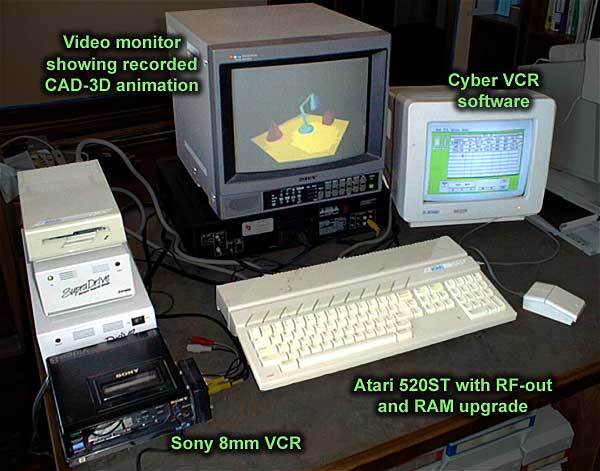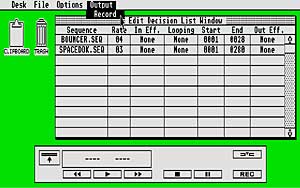Cyber VCR
Cyber VCR, by Tom Hudson, was a unique program for sequencing Cyber animations and recording the sequence to videotape. Cyber VCR worked with Sony Betamax and Sony 8mm consumer video equipment that featured the CTL-L cable interface. Cyber VCR was certainly amongst the first consumer computer products that controlled a VCR for the purposes of recording animation (or anything else, for that matter).

As Cyber Studio was coming together, Gary Yost had been experimenting with assembling SEQ files to a standard VHS VCR, and had discovered how unsatisfactory the noisy edits and manual button-pushing process were. But at the Atlanta Spring COMDEX convention in 1987, Gary saw new products in the Sony booth that were exciting: Sony had introduced new 8mm and Betamax VCRs that featured both flying erase heads (for relatively clean edits) and a new cable interface called CTL-L. In this new equipment, Gary immediately recognized a potential solution for recording animation to video, specifically CAD-3D and Cyber Paint animation:
I went to Sony first and showed them what we'd done on the ST and explained what we could do with their new 8mm/CTL-L line of products. They were quite excited and gave me two decks and some cables to experiment with. I had told Tom what I was up to and of course he was excited, so when I got the decks I sent one to him along with both cables and he modified one end of each of the cables by putting an RS-232 connector on it.
Actually, the RS-232 connector didn't work; the Sony CTL-L specification wasn't compatible with the UARTs (a computer component that handles serial communication) in the Atari ST. Sony had sent along a wiring diagram and a list of deck commands, but it wasn't much. Gary and Tom once again turned to Mark Kimball and his prodigious experience making computers and electronic equipment talk to each other. Tom says:
My main work was on the application side and working up a way to make the non-frame-accurate VCR work acceptably well with what we wanted to do. ... The driver code Mark wrote is about 300 lines of assembly code, with comments, which isn't a lot. I can see where he had to deal with some timing issues by adding NOP (No-Operation) lines, though. Probably wasn't a lot of fun for him!
Mark found that the Atari’s parallel port (printer) interface would do the job. The biggest trick was generating the correct timing for the 1’s and 0’s being sent to the VCR, and he adapted the cable and wrote an assembly-language driver to make it work. Mark relates:
The first time I got the VCR to respond to my commands, with my own code, was quite a kick. Things like that are the reason for hacking, I believe.
The basic requirement for the new project that would become Cyber VCR was “to be able to construct an edit list of individual sequences and lay those seamlessly to tape”. With Mark’s driver, this was really not a particularly difficult goal to reach. Tom created a very direct drag-and-drop EDL (edit decision list) interface using stock TOS and GEM elements. The animation handling code was simply adapted from Cyber Paint. Cyber VCR was probably the quickest major Cyber product to program.
The problem with publishing Cyber VCR was that it required the custom cable. Although Antic had resold some hardware products (such as the Tektronix StereoTek 3D glasses), they had specifically avoided the investment and risks of developing their own hardware products. Gary fought hard and managed to get the cables made, but the process took a while and may have slowed the release of the product by a few months.
Cyber VCR was a critical piece of the Cyber puzzle because—although it wasn't professional in nature—it provided a link to the videotape-based professional videographics world, and really drove home the integrated nature of the Cyber software. Gary and Tom’s later opportunities with Autodesk can be partially tied to this product. Gary explains:
At the November ’87 COMDEX we had a whole table of the Atari booth set up with a “desktop video” system based around Cyber Studio and Cyber VCR. We also had a second deck running animations off the 8mm tape that we were producing on the spot. It was sweet, and during the show David Kalish of Autodesk brought Eric Lyons and everyone else from Autodesk he could grab to see what we were doing. David owned an Atari ST that he'd bought for his son and subsequent to the show bought all our products for him to play around with. In early January, David called me and told me he wanted to meet so we could discuss how to bring all this technology over to the PC. In fact, he even said that if Autodesk wasn't interested, he wanted to put together a list of private investors (headed by David) to get us onto the project ASAP. That was one of the most exciting telephone calls of my life, for sure. (And Cyber VCR was instrumental in lighting the path for us.)
Edit Decision List (EDL)
A list that describes in terms of time (and frame numbers) how to combine separate “shots” of a film or animation into a finished, “edited” production.
Frame accurate
Frame acccuracy is the degree to which a video recording device can track, start and stop on specific video frames. Truly frame accurate video devices tend to be relatively expensive because it is difficult to get such a complex electromechanical devices act with such precision.
Assembly language
The most rigorous and fundamental language available to a programmer for developing software; typically only used to develop extremely optimized mathematical algorithms. Assembly language programming generally requires special expertise.
Flying Erase Head
Videotape recorders use a spinning cylinder (“head”) to read and write video signal on a magnetic tape. Erasure is done by an element that is typically separate, which means that the act of erasing does not happen concurrently at the exact same place on the tape as the head that does the recording and reading. A flying erase head is where the erasing element has been integrated on the same head as the read/write element(s), making the device more complex and expensive, but also better suited to making good edits.
Desktop Video
The Macintosh and Aldus Pagemaker in the mid 1980’s created the Desktop Publishing industry, which enabled people with relatively inexpensive computers to do (somewhat) professional-grade page layout. Desktop Video is a concept that followed on the heels of Desktop Publishing and proposed to do the same for digital video production. Desktop Video exploded in the early 1990s led by Avid, and now is ubiquitous, particularly with the advent of the DV/miniDV camcorder.
GEM and TOS
The operating system of the Atari ST-series of personal computers was called TOS (Tramiel Operating System), which was a superset of Digital Research’s GEM (Graphical Environment Manager) system. In short, it was responsible for the Macintosh-like features (windows, drop-down menus, the mouse pointer) in most of these Antic software products.
